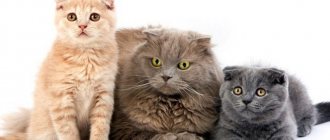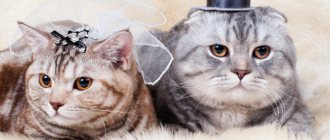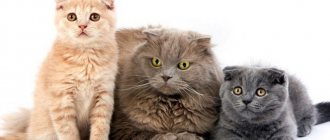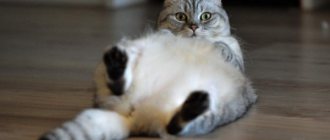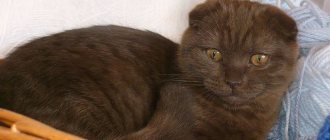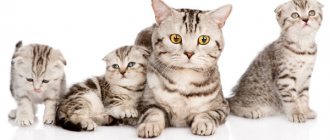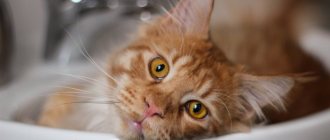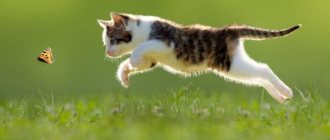We choose a kitten not only with our minds, but also with our hearts. After all, we will have to walk side by side with our pet for the next 15-20 years. He will become a member of the family. He will live with us in perfect harmony... Or vice versa? This depends, among other things, on how correctly we select our future friend, singling him out from among all the others. So, how to choose the right Scottish fold and straight-eared kitten - healthy, purebred, beautiful, with a good character? And what are the features of Scottish fold and straight-eared kittens that distinguish them from all the others?
MAIN THOUGHTS OF THE ARTICLE
► unscrupulous sellers, under the guise of Scottish ones, sell mongrels or mestizos;► choosing a Scottish kitten with good breed characteristics is difficult without experience, but we will try to teach;
► good kittens cannot be cheap; they are sold in certified nurseries by certified felinologists;
► the price depends on the class of the kitten.
Choosing a kitten class
Breeders know that the division into classes is very arbitrary: it only helps determine the baby’s career prospects . Often kittens of the same litter fall into different classes, but this is always the personal point of view of the breeder. In addition, in the process of growth there are transitions from breed to pet, from show to breed and vice versa.
Show class (show – display, demonstration)
This includes kittens that fully comply with the breed standard, without disqualifying characteristics or shortcomings. Reference cats are included in the top show class (top – top, highest). These animals remain in nurseries for breeding and exhibition activities. Show-class kittens (the pride, decoration and advertising of the nursery) are practically not put up for sale. Such copies are sold for a lot of money and with reservations - “on conditions” or “in co-ownership”.
Breed class (breed – tribe)
This group is represented only by cats with excellent pedigrees and excellent reproductive capabilities. They also appear at shows and win titles that give them the right to participate in breeding. With proper selection, show-class offspring are obtained from such females.
This is interesting! Breeding males usually fall into the pet category, since a breeding cat is judged not so much by its pedigree and conformation, but by the health and quality of the kittens it produces.
Such animals are often sold with the condition of mandatory removal of the reproductive organs, which does not prevent them from having a pedigree and claiming exhibition regalia (in the “castrati” category). The price for breed-class cats is in the average price range. It happens that show-class kittens are found among breed-quality animals. This happens due to oversight or due to insufficient experience of the breeder.
Pet class (pet – pet)
These are purebred kittens that, in the opinion of the breeder, are not of interest either for exhibitions or for breeding. They often have disqualifying defects that do not threaten health or life.
Such kittens are sold already neutered or with the condition of spaying. A pedigree for a pet-class animal is issued only at the request of the buyer: in this case, the entry “not for breeding” appears in the documents. The cost of pet quality kittens is the lowest.
Return to content
Deciding on the purpose of purchase
First, decide for what purpose you want to get an animal: as a pet, for participation in exhibitions or for breeding. Depending on whether your interests relate to all three points or only some, you can determine the class of the future cat:
- Pet. The cheapest category. As a rule, a pet-class kitten has a deviation from the standard that is safe for health. Usually this concerns unacceptable color, bite, irregular ear shape, etc. Sometimes this class includes babies without defects, who simply do not reach the exhibition level. As a rule, such kittens are sold subject to sterilization. If you only need a pet, you can safely choose this group: the animal’s friendly character will not be affected by external characteristics, and besides, a color that is unacceptable according to the standard does not mean “ugly.”
- Breeding. Only cats belong to this category. As a rule, they have minor defects - not disqualifying, but only reducing the rating at exhibitions (irregular coat texture, too wide-set eyes, etc.). With the right choice of partner, such animals are capable of producing show-class offspring, and they themselves can sometimes take a prize at an exhibition (as a rule, the possible title is limited to “Breed Champion”). Many people get such pets just for home.
- Show. Promising kittens, most often with an impressive pedigree. They can take part in exhibitions and be used for breeding. This is a very expensive option, so such animals are rarely kept as ordinary pets.
Choosing the gender of the kitten
When thinking about who is more useful on the farm, a cat or a male cat, you should not blindly trust the description of the breed’s character, as well as theses about the greater affection of females and the unsociability of males. In practice, everything may turn out differently, since the disposition of the future pet depends little on its gender, and sometimes even contradicts the breed characteristics.
That is why, when deciding on the gender of the Scottish Fold, proceed from a specific goal . If the breeder's laurels attract you, buy a breed or show-class female. You can, of course, take a breeding cat, but keep in mind that the requirements for males are much higher, and they are somewhat more difficult to maintain.
Important! When buying an elite "Scottish" there is always a certain risk: a maturing kitten may not live up to high expectations and descend into a lower (unsuitable for breeding) class.
It is much easier for those who choose a Scottish Fold solely to enliven family leisure time . In this case, as a rule, the choice falls on the boy. Firstly, castrating an animal is somewhat easier than sterilizing it. Secondly, adult cats (due to their size) look more respectable and more prestigious than female cats.
Return to content
What age is best to take
The kitten is not separated from its healthy mother for at least two months: during this time, it drinks its mother’s milk, rich in antibodies, and strengthens its immunity. Early (at 1 month) separation from a cat is fraught with stress, which negatively affects the health of babies. It is preferable to select a Scottish Fold in the range from 3 to 9 months, in the so-called adolescence. At this time, the “Scots” become long-legged, slightly awkward and stretched out, like all teenagers: against this background, the breed’s shortcomings clearly appear.
If by this age the baby still has large ears, a loose undercoat and a thin tail, do not entertain the illusion that the ears will shrink, the undercoat will grow, and the tail will become shorter and thicker. An exemplary “teenage” Scottish Fold has a thick muzzle, powerful paws, small neat ears, “stuffed” hair and a not particularly long tail.
Return to content
What documents should there be?
The purebred Scottish Fold cat, as well as its health parameters, must be confirmed by official documents:
- metric or pedigree;
- certificate of registration (for American organizations);
- purchase agreement;
- veterinary passport;
- transfer to own a cat (in rare cases);
- veterinary certificate No. 1 (for imported animals).
Important! A serious nursery will not sell cheap kittens without documents and expensive ones with documents. From a responsible breeder, all animals have documents issued simultaneously for the litter, which is registered as a whole.
If you receive a metric in your hands, the pedigree is no longer needed, and vice versa. But the breeder is obliged to hand over one of these main papers, regardless of the purpose of acquiring the “Scot” - for breeding or castration.
Documentation of the litter in the breed club is strictly regulated, but is inexpensive. All papers received from the breeder minimize your potential risks: you will always return the animal and the money spent if it is found to have congenital anomalies.
Metrics
This is a birth certificate issued after the animal is registered in the club system. The following must be included in the document (where the emblem of the system to which the “Scotsman” is assigned) is affixed:
- Name;
- date of birth;
- gender and breed;
- color;
- names/colors of manufacturers;
- breeder's name and other information.
The European certificate is affixed with the seal of the club and the signature of the responsible person who activated the litter: this is necessary to exchange the metric for the pedigree. In American systems, a slip (metric) is used to register a kitten and obtain a pedigree through the central office.
Pedigree
This includes the kitten’s ancestors (up to 3–5 generations) with their names, colors and pedigree numbers . This document contains the name of the nursery and club, the association's emblem, information about the kitten, as well as the names of the breeder and owner.
Attention! The “owner” column should contain your name, not the name of the breeder. To do this, obtain a pedigree yourself or agree with the breeder to prepare it in advance.
European pedigrees are provided with a number, the seal of the club and the signature of its leader, American pedigrees - only with a number . Pedigree in the USA is informative, and pedigree is confirmed by registering the kitten (and its litter) in the system according to its rules.
In European associations, you may be given a pedigree without a number or marked “pet”, or not at all if you adopted a “Scot” for castration. If you want to draw up a pedigree yourself (provided you have a metric), do it before the pet turns one year old. If you are not going to breed purebred cats, you won't need a pedigree.
Veterinary passport
Information such as:
- name and gender of the kitten;
- breed and date of birth;
- vaccination records (with a veterinary clinic stamp, a special sticker and a doctor’s signature);
- owner/breeder's name.
Despite the fact that a veterinary passport is issued to every purebred animal, it cannot serve as confirmation of the breed: the veterinary passport is filled out by the breeder or doctor, and clubs and felinological associations are responsible for the purity of the breed.
Other documents
All other documents (certificate of registration of the kitten in the system, transfer of ownership, veterinary certificate in form No. 1) are optional, that is, optional. An exception is a purchase and sale agreement, which will protect your rights if an unscrupulous breeder sells you a cat that is known to be sick.
Important! A Scottish Fold cat without documents is not recognized as a purebred cat and is automatically excluded from breeding.
Return to content
Family Unity
Another important question: did all family members joyfully accept the news about the new member of the household? The psychological microclimate in your family largely depends on unity in making this decision. If a pet feels rejection from a person, this can lead to a variety of consequences.
Therefore, at the time of choosing a specific baby and communicating with the breeder, it is desirable that the whole family be united on this issue.
It is worth noting that if you want to buy a Scottish kitten in Moscow, or in any other city, but cannot find one like the one you drew for yourself, or saw in the photo, then contact nurseries in other regions. Many of them work with auto, rail and air delivery, and video calls will help you make the right choice!
Choosing a healthy kitten
More stringent criteria are applied when selecting kittens for breeding. Applicants must be sufficiently mature: if possible, they are purchased in the fall, since the heat makes its own adjustments to the exterior. Some kittens' ears stand up or stand up completely. In this case, decide for yourself whether you definitely need a Scottish fold or whether a Scottish straight will suit you, especially since the latter will also produce babies with rolled-up ears.
When examining the kitten, pay attention to the configuration of the bite - in the Scottish Fold it is scissor-shaped. Cats (unlike dogs) do not have such strict requirements for their teeth: the main thing is that they are complete, intact and even. It happens that the color of an adult “Scotsman” is strikingly different from what was stated when purchasing it.
In order not to be disappointed in your expectations, write this clause in the contract, and choose a kitten together with a person who can give a forecast on the final coat color of a mature pet. The kitten you choose should be healthy and playful, have a thick and uniform coat, without spots or gaps. No dirt in the ears. The eyes should shine, but not from tears or painful discharge. A healthy kitten is always interested in what is happening: lethargy and apathy are excluded.
Return to content
Scottish fold kitten price
The breed is in demand both in our country and abroad. In Russia, dozens of nurseries are engaged in breeding Scottish fold cats, from the capital to the periphery. “Scots” are bred in Yekaterinburg, Tambov, Ulyanovsk, Tyumen, Yoshkar-Ola, Stavropol, Samara, Tver, Vladimir, Izhevsk, Saratov, Veliky Novgorod, Zelenokumsk, Kostroma and more.
The price for a kitten with a pedigree starts from 8 thousand rubles and reaches 20-25 thousand. On average, purebred babies are put up for sale for 15 thousand rubles. Please also note that the Scottish Fold will cost you a little more than its sibling with straight ears (even if the breeder assigned the same quality class to both of them).
Return to content
What affects the cost
Let's now find out how much a Scottish kitten costs.
- The cost of pet-class babies starts from 6 thousand rubles. It depends on the type of defect and the beauty of the color.
- A breed-class cat can be purchased for 18 thousand rubles. and higher depending on her own merits and promising breeding qualities.
- The price for a show-class animal can reach up to 180 thousand rubles. It depends on the breed data and how many awards the parents (and the kitten itself, if it has already been taken to exhibitions) received.
Think carefully about your own capabilities and desires, and if necessary, consult with a specialist. Finally, carefully examine your future pet so that later this purchase will bring maximum joy.
Source
Breeders' advice
Breeders are reminded that the Scottish Fold cat can be very different. In one litter, both Scottish Straights (with straight ears) and Scottish Folds (with envelope ears) are born.
Moreover, both varieties can have not short, but semi-long hair. Then they will be called Highland Straights (Scottish Straight Longhair) or Highland Folds (Scottish Fold Longhair).
Lop-eared and straight-eared
Scottish Straights differ from their fold-eared relatives only in the position of their ears, maintaining the indescribable charm of the breed as a whole - they, like Folds, are round-eyed, respectable and charming. Breeding work with the Scottish Fold is full of surprises, since mating occurs exclusively between fold and straight.
This is interesting! Crossbreeding of sires belonging to the same type - Scottish Fold - is prohibited throughout the world. It has been noticed that such matings produce kittens with bone tissue abnormalities.
With a 50/50 probability, a straight-eared cat can also produce fold-eared offspring . In practice, the distribution of straight-eared and fold-eared babies in one litter cannot be planned: sometimes all newborns have envelope ears, sometimes the entire litter is decorated with straight ears.
Short-haired and long-haired
Short-haired animals have a soft, but quite dense coat, reminiscent of plush to the touch. Highlands (with long hair) can be born from both long-haired and short-haired sires (if they have the recessive gene for long hair).
This is interesting! Often, a cat gives birth to completely different kittens, and in one litter there are 4 recognized variations of the breed, with different ear shapes and different coat lengths.
The Highland coat cannot be cottony (this is considered a flaw), but must be silky and airy, not matting and requiring almost no maintenance. The abundant fur of the “Scots” does not spoil, but even more focuses attention on their rounded head and expressive round eyes.
Return to content
External factors
Now let's figure out how to choose a real Scottish kitten. Very often, under the guise of Scots, they sell British or even mongrel children. Before you make a purchase, it’s worth visiting specialized nurseries to get an idea of what Scottish Fold kittens might look like.
Let us note the main external signs of the Scots:
- the fur is short, as if plush;
- very reminiscent of little bear cubs;
- the eyes are round and large, slightly slanted;
- the head looks like a fur ball;
- folds have drooping ears, while straights have straight ears;
- if you look from the side, the mouth “smiles”;
- neat nose;
- ideal representatives of the breed have a “childish” face;
- Parents of children should also have pedigrees.
Scottish cats can come in different colors: you can find black, white “teddy bear” cats, as well as cream, blue and even red. There are a huge number of coat patterns, such as brindle, spotted. There are representatives who have a mixture of colors and patterns.

